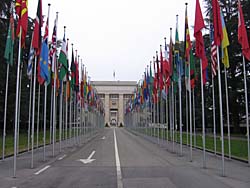
Unit 4: Nationalism, Industrialism, and Imperialism
Lesson I: The Dual Forces of Nationalism
Lesson Overview

Member Flags of the United Nations at Geneva [1]
The most influential idea of the nineteenth century was nationalism. Nationalism is a collective feeling of membership and loyalty to a country, a community that has a shared culture, history, language, and territory. Previously, most people had considered themselves subjects of a ruler rather than as citizens of a country. This perception changed largely due to the spread of the ideas of political revolutionaries and Enlightenment thinkers of the previous century. Nationalism served as a force of unity for many countries and regions, including the countries facing the threat of imperialism and colonialism. At the same time, for others nationalism was a more destructive force and led to the breakup of empires. As nationalistic movements spread people began forming new loyalties and identities, transforming societies and the world.
Key Questions
- How does the development of nationalism impact people, countries, and empires?
- What characteristics and factors unite people as a country?
- Is there such a thing as completely unbiased history?
- How do geography and location affect historical events?
Student Outcomes
- Analyze how nationalism was a source of tension and conflict in places such as the Ottoman Empire.
- Explore how events during the 19th century, such as imperialism, led to the rise of nationalist movements in China, India, Egypt, Russia, and Japan.
- Assess the impact of nationalism on the unification movements in Germany and Italy.
- Compare nationalist movements in different regions of the world, such as Latin America, Africa, South Asia, and the Middle East.
- Draw comparisons across eras and regions in order to define enduring issues. (Historical Thinking Skill)
- Analyze cause-and-effect relationships and multiple causation, including the importance of the individual and the influence of ideas. (Historical Thinking Skill)
Key Terms
Student Resources
- Historical Investigation - Bismarck and German Unification (doc)
- Colonial Resistance Jigsaw Fact Sheet (pdf)
- Colonial Resistance Jigsaw Graphic Organizer (doc)
- Global Comparison of Nationalism Brief Constructed Response (BCR) (doc)
Chart of Activities
| Activities to Complete | Estimated Time |
|---|---|
| Pre-Assessment: The Dual Forces of Nationalism | 5 minutes |
| Key Terms: The Dual Forces of Nationalism | 5 minutes |
| Activator: The World 1815-1914 | 10 minutes |
| Opening: The Impacts of Nationalism | 10 minutes |
| Activity 1: Nationalism Unites Italy and Germany | 10 minutes |
| Activity 2: Causes of Unification | 5 minutes |
| Activity 3: Bismarck and German Unification | 20 minutes |
| Activity 4: Nationalism Brings Conflict to the Ottomans | 10 minutes |
| Activity 5: Nationalism in Europe vs. Middle East | 5 minutes |
| Activity 6: Nationalism in Colonial Resistance | 15 minutes |
| Review and Assessment | 10 minutes |
| Lesson Summary: The Duel Forces of Nationalism | 5 minutes |
Lesson Completion Time
The total estimated time to complete this lesson is 110 minutes.
Page Notes:
[1] Source: This image from http://commons.wikimedia.org/wiki/File:UNGENEVA.jpg is licensed under the terms of the GNU License Agreement.

